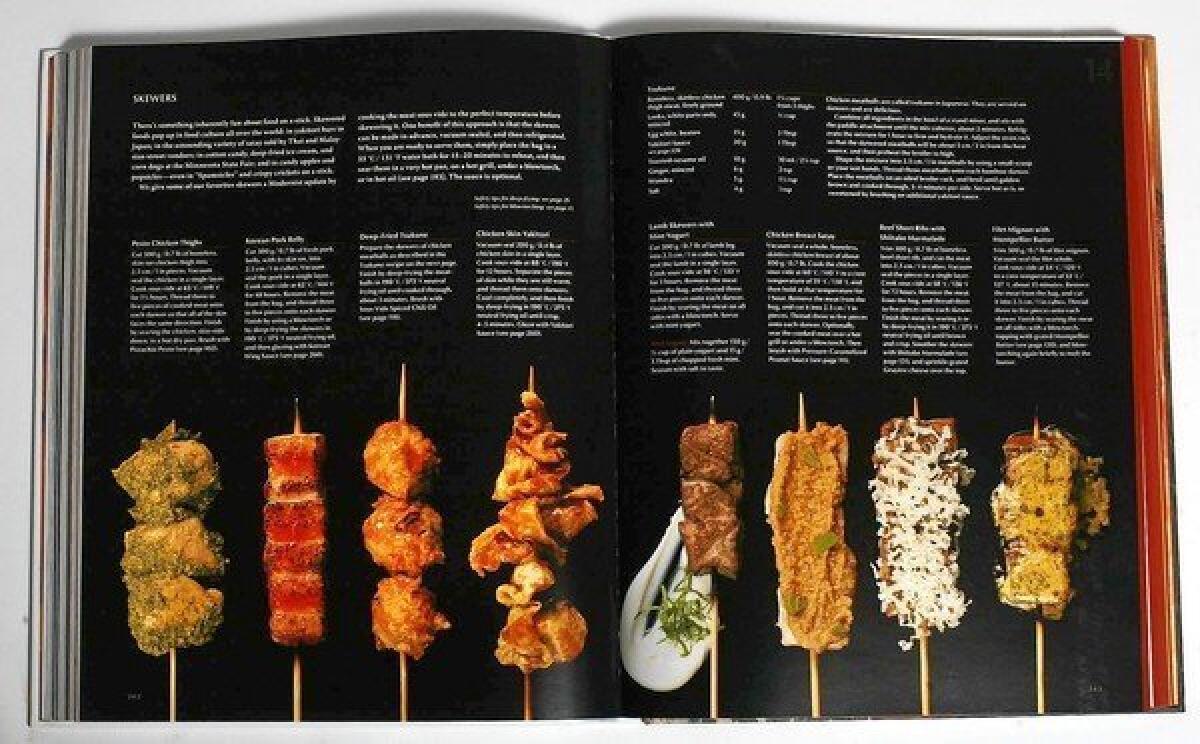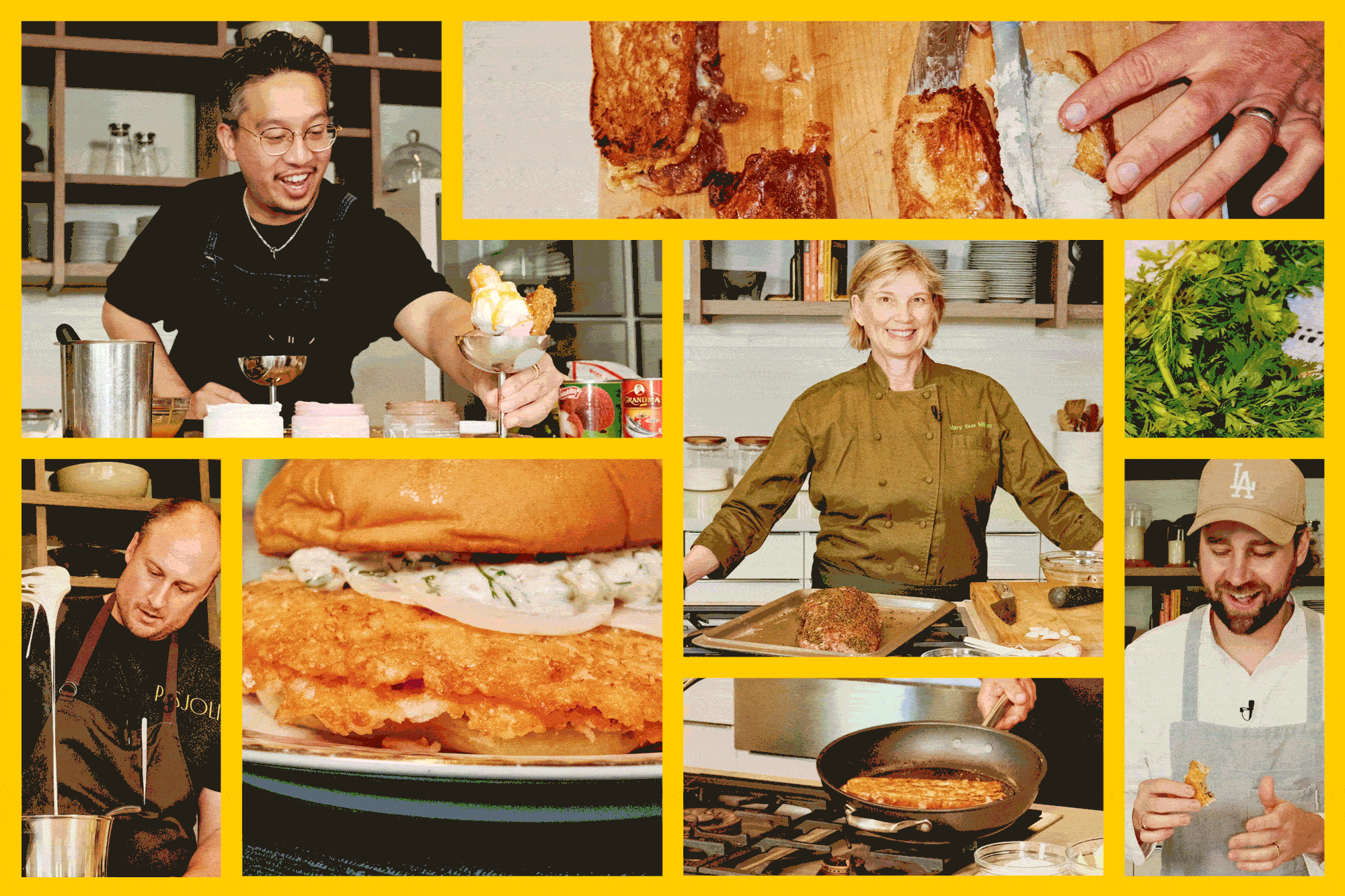The California Cook: Squinting into the future of cooking

Here’s how you make a really good roast chicken: Pat the skin dry and season it with salt and thyme leaves; quarter a lemon and stick it in the cavity; roast at 400 degrees until the drumstick swivels easily when you turn it. It takes about an hour, with active cooking taking 15 minutes at the most.
Here’s how Nathan Myhrvold roasts a chicken in his new book, “Modernist Cuisine at Home”: Remove the wishbone and French the drumsticks; make a brine and inject it into the breasts, legs and thighs; blanch the chicken in boiling water for 20 seconds, then plunge it into an ice water bath for 20 seconds, repeat twice more; pat it dry, season it with soy sauce and refrigerate it overnight; roast at precisely 205 degrees to a core temperature of 140 degrees; rest for 45 minutes (the bird, not you); brush with oil and place under the broiler, turning once, until the skin is crisp. It takes the better part of two days, with at least a couple of hours of busy fussing.
For those of you who haven’t been keeping up with the latest in culinary tweaking, modernist cuisine (sometimes called molecular gastronomy) is all about bringing the latest techniques of scientific food processing to restaurant and home kitchens.
It involves using specialized equipment, such as immersion circulators that can cook foods for long periods at very precisely controlled low temperatures. And it incorporates ingredients that once were found only in laboratories or food factories, such as starches and gums that thicken liquids more efficiently than old-fashioned flour and gelatin.
Myhrvold is the former chief technology officer at Microsoft who in his semi-retirement has turned into a kind of guru of the molecular movement, having built a laboratory kitchen and spent more than four years working with a team to publish the original “Modernist Cuisine,” a five-volume, $625 combination cookbook and textbook so massive that one critic confessed it would take him several years before he could adequately assess it.
Apparently recognizing that not everyone was ready for quite that deep a plunge (though it has sold through three printings), Myhrvold is aiming a touch lower with “Modernist Cuisine at Home,” which is coming out in early October — just as lavishly produced but much abridged (only 400 pages, three-fourths of them illustrated recipes) and cheaper (still, $140).
Having spent a couple of weeks with an advance copy, I’m afraid I’m still not quite sure what to make of it either.
First, let’s get one thing out of the way. One of the cardinal sins of reviewing is critiquing the book you wanted the author to have written rather than the one in front of you. Still, I was dogged by the wish that Myhrvold had turned his vast knowledge to helping real home cooks rather than teaching hobbyists how to mimic avant-garde restaurant chefs.
But Myhrvold is a really smart, talented guy, and I know a lot of other really smart, talented guys who are into this kind of cooking as well (and, yes, they are almost all guys). So I thought I’d take at least a tentative shot at becoming modern. The results were mixed, but positive enough to keep me going.
The first bump I ran into is probably one that will be shared by a lot of home cooks: Almost all of the recipes required either equipment or ingredients that I don’t have.
My kitchen is pretty fully stocked (just ask my wife). In fact, I even have an immersion circulator. But to really get into this book, I probably also should have bought a vacuum sealer, a juicer, a high-power blender, a dehydrator and a whipped cream siphon. To say nothing of an injector and a blowtorch. All told, you’re probably looking at more than $1,000.
And when it comes to ingredients … I’m afraid I’m fresh out of agar agar, sodium citrate and vital wheat gluten.
The bigger issue, though, was finding something in the book that I wanted to cook. There were several recipes that looked good, but on closer examination, most of them seemed to revolve around some modernist complication that would improve the dish only incrementally, if at all. If I’m going to invest in expensive equipment or arcane ingredients, I need to have my mind blown.
The vichyssoise, for example, is thickened with diastatic malt powder. Myhrvold says the texture is incredibly silky, but I’ve always been perfectly happy with potatoes, leeks and cream. The hollandaise requires sous-vide cooking the egg yolk base for half an hour. Really? For a blender hollandaise? Pesto is set with xanthan gum. And don’t even ask about the hamburger.
In the end, I tried the basic sous-vide chicken — sealed in a zippered plastic bag (I don’t have a vacuum sealer), the thighs cooked for 90 minutes in 149-degree water while the breasts are cooked for 40 minutes in 144-degree water.
I served that with pressure-cooker mushroom jus made by cooking browned mushrooms and shallots under pressure with water, sherry and white wine, straining and finishing with white miso and soy sauce.
I’ve made pressure cooker stocks before and been happy with them, but this one lacked depth of flavor. Even after I beefed it up by reducing it with more sautéed mushrooms, it still seemed thin. I might try it again, using chicken stock in place of the water, or including some dried mushrooms. Or maybe both.
The chicken worked much better. In fact, it was three-quarters of the way to amazing. The meat stayed incredibly moist without any of that rubbery texture I sometimes find in sous-vide cooked meats. The thigh pulled cleanly away from the bone without any sign of being overcooked. The breast was done evenly through without a sign of drying.
The only drawback was the skin, which had that flabby texture of boiled bird. Following Myhrvold’s advice, I seared it in a scorching pan before serving, but even though it browned, it never did crisp.
Maybe I do need to break down and get that blowtorch.
Still, that was enough of a glimpse of the future to keep me going. I’m certainly not ready to give up on modernism. In fact, there are a few things I’m still eager to try — Paula Wolfert insists that cooking duck confit sous-vide is the bomb.
And it could be that in five years this kind of cooking will have become so mainstream I’ll be eating these words. They’re pretty tough, though, so maybe 72 hours at 136 degrees?
More to Read
Eat your way across L.A.
Get our weekly Tasting Notes newsletter for reviews, news and more.
You may occasionally receive promotional content from the Los Angeles Times.










